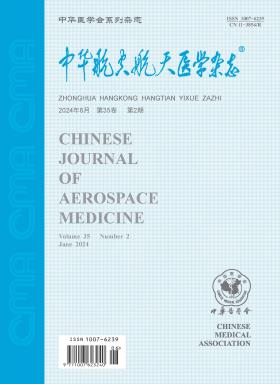神经对比敏感度在评价暗适应和夜视镜辅助视觉性能中的价值
引用次数: 0
摘要
目的应用神经对比敏感度(NCS)评价暗适应镜和夜视镜辅助视功能,并与对比敏感度(CS)进行比较,探讨神经对比敏感度(NCS)评价视功能的价值。方法招募8名健康男性志愿者(8只眼),对右眼进行检测。采用视觉监测系统测量不同环境亮度水平(10-1-10-4 cd/m2)下,光适应、暗适应和NVG组志愿者的CS曲线。利用光学质量分析系统测量了调制传递函数(MTF)曲线。NCS定义为CS与MTF的比值。结果在中低频范围内(空间频率为0.6 ~ 3.4周/度),暗适应使暗视环境下被试的NCS和CS显著升高,而对中视环境的影响较小。在暗视和中视环境下(空间频率为1.1-7.1周期/度),NVG显著改善了受试者的NCS和CS,且比暗适应更有效。在高空间频率范围内,暗适应和NVG对受试者的NCS和CS均无明显改善作用。结论暗适应和窥镜均能改善暗视环境下的视觉表现,但窥镜效果更好。CS曲线可以代表综合的视觉表现,NCS反映视网膜-脑神经系统的功能。但在测量CS较差的情况下,NCS和MTF有助于找到原因。建议将NCS和MTF与CS相结合进行检测。关键词:对比灵敏度;暗适应;视野;夜视镜本文章由计算机程序翻译,如有差异,请以英文原文为准。
Value of neural contrast sensitivity on evaluating dark adapted and night vision goggle aided visual performance
Objective
To apply neural contrast sensitivity (NCS) on evaluating the dark adapted and night vision goggle (NVG) aided visual performance upon the comparison with contrast sensitivity (CS) and to investigate the value of NCS in the assessment of visual performance.
Methods
Eight healthy male volunteers (8 eyes) were recruited for this study, and the right eye was tested in this experiment. CS curves of volunteers in light adaptation, dark adaptation and with NVG were measured by Vision Monitor System in different environment luminance levels (10-1-10-4 cd/m2). Modulation transfer function (MTF) curves were measured by optical quality analysis system. NCS was defined as the ratio of CS and MTF.
Results
In lower and medium frequency range (spatial frequency was 0.6-3.4 cycle/degree), dark adaptation made subject′s NCS and CS mount up considerably in the scotopic vision environment, but less effect in mesopic vision environment. NVG considerably improved subject′s NCS and CS both in scotopic and mesopic vision environments (spatial frequency was 1.1-7.1 cycle/degree) and more effective than in dark adaptation. In high spatial frequency range, neither dark adaptation nor NVG had obvious effect on improving subject′s NCS and CS.
Conclusions
Both dark adaptation and snooper scopes can improve visual performance in the scotopic vision environment, but snooper scopes is better. CS curves can represent the comprehensive visual performance, NCS reflects the function of the retina-brain neural system. But NCS and MTF would be helpful to find the reasons in case of poor CS measured. The examination combined NCS and MTF with CS is suggested.
Key words:
Contrast sensitivity; Dark adaptation; Vision; Night vision goggles
求助全文
通过发布文献求助,成功后即可免费获取论文全文。
去求助
来源期刊

中华航空航天医学杂志
航空航天医学
自引率
0.00%
发文量
2962
期刊介绍:
The aim of Chinese Journal of Aerospace Medicine is to combine theory and practice, improve and popularize, actively advocate a hundred flowers bloom and a hundred schools of thought contend, advocate seeking truth from facts, promote the development of the related disciplines of aerospace medicine and human efficiency, and promote the exchange and penetration of aerospace medicine and human efficiency with other biomedical and engineering specialties.
Topics of interest for Chinese Journal of Aerospace Medicine include:
-The content of the journal belongs to the discipline of special medicine and military medicine, with the characteristics of multidisciplinary synthesis and cross-penetration, and mainly reflected in the aerospace industry, aerospace flight safety and efficiency, as well as the synthesis of special medicine, preventive medicine, environmental medicine, psychology, etc.
-Military aeromedicine (Air Force, Navy and Army aeromedicine) and civil aeromedicine, with a balance of aerospace medicine are the strengths of the journal.
-The change in aerospace medicine from a focus on promoting physiological compensatory adaptations to enhancing human performance under extreme environmental conditions is what the journal is helping to promote.
-The expansion of manuscripts in high altitude medicine is also a special emphasis of the journal.
 求助内容:
求助内容: 应助结果提醒方式:
应助结果提醒方式:


